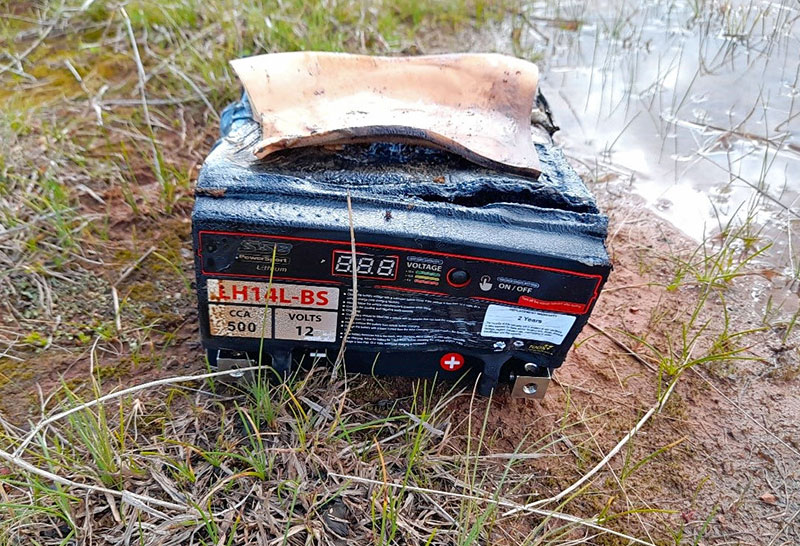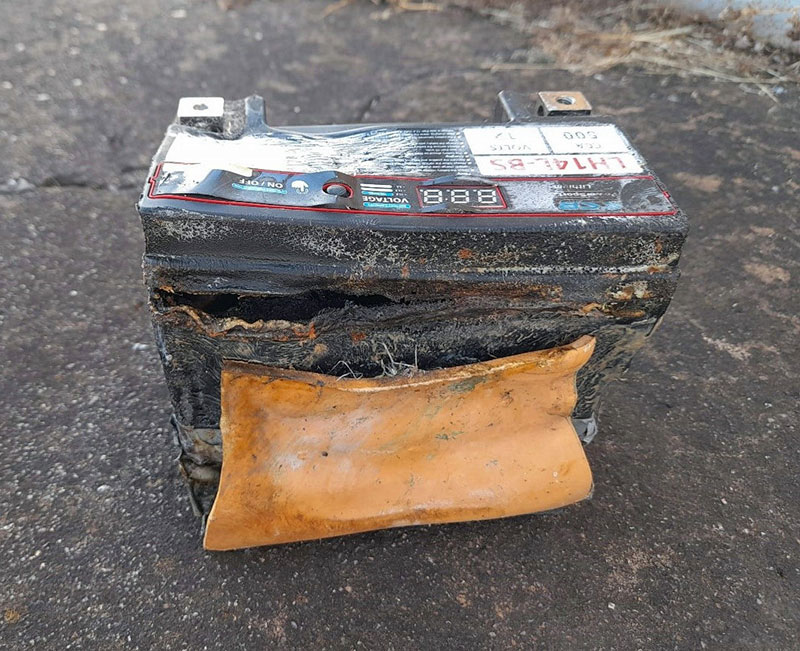
Battery after removal from aircraft.
In August 2022 I was flying my self-launching glider. I had decided to do a long power-on climb to about 6,000ft AGL to test the engine performance in a style of flight different to my normal usage. The engine started normally, the climb was uneventful and shut down and retraction as normal.
I flew about, gradually losing height, and planned on an engine restart at about 4,000ft AGL to test the systems again. I was about 10km upwind of the airfield when I commenced restart. The engine extended but did not crank over. I made a few attempts at starting before trying a retraction. The engine failed to retract. I decided to return to the airfield and land engine up.
At this stage, I was annoyed but not overly worried. However, on descent I heard a popping noise from behind me in the aircraft and, getting a bit more worried, decided to expedite the landing.
Landing was relatively straightforward, using a long sealed runway into wind. I rolled off at a taxiway and exited the cockpit. Fumes could be seen exiting the battery box in the engine bay. I was now very concerned. I grabbed a pair of leather riggers gloves and a screwdriver and removed the battery (lithium type) from the aircraft and placed it on the ground about 30m away. It was clearly quite hot and the case was deformed. Other pilots in the vicinity started to show interest, possibly noticing the foul smell.
On the way home I had plenty of time to ponder the event. This is the closest I have ever been to needing to exit the aircraft in flight or possibly even becoming a sad statistic.
A SOAR report was lodged
A few weeks later a replacement battery (AGM lead-acid) was fitted, and the charging circuit tested. The voltage regulator had failed and the Rotax engine was acting as a totally unregulated charger. The charging fuse was removed to disable the alternator and, until a new regulator is fitted, the battery is removed after each flight for charging.
Some discussion of how I ended up in this situation is warranted. I was aware that lithium batteries are generally not approved for use in gliders. The aircraft was an Experimental SLG designed to be operated at a Maximum Take Off mass of 322kg. The starting battery was mounted in an aluminium cradle in the engine bay aft of the C of G.
The previous owner had twice broken the rear fuse of the aircraft in ground incidents. These repairs had added weight to the rear of the aircraft and even a small reduction in battery weight was helpful in keeping the pilot weight range usable. I decided to try a lightweight battery and a motorcycle lithium starting battery was the best fit. In hindsight I should have considered the risks much more closely.
The aircraft had operated for a year with the lithium battery and then been laid up for some time. Last winter I returned the aircraft to use, planning on a trip with it in spring. I had starting issues after a few flights and replaced the battery with one of the same model. A few successful flights were conducted prior to this incident. I expect the regulator may have failed some time ago but when doing 2,000ft launches, the fault wasn’t as apparent. The glider does not have a voltmeter fitted. There is room for improvement with the current setup, but it will not include a lithium battery.

Final state of battery after incident.
Comments from the Airworthiness Panel
This story highlights the dangers of making unapproved alterations to a sailplane. It is disappointing that the owner of this sailplane was aware that lithium batteries weren't approved but chose to fit the battery regardless.
The problem was caused by the fact that the recharging system was not designed for a lithium battery. There are some very good reasons why the rules stipulate against inflight recharging of lithium batteries, unless approved by the sailplane manufacturer.
Lead-acid batteries have a high internal resistance, while lithium batteries have a low internal resistance. The higher internal resistance means lead-acid batteries will draw less current than a lithium battery during charging, unless the charger or regulator is smart enough to restrict current. Most are only very simple voltage controlling devices. As a result, when a lithium battery is connected, too much power is being drawn through the voltage regulator, which overheats.
The rated maximum standard charging currents are
Lead: <0.4 x Capacity
LiPo: <1 x Capacity
LiFePO4: <4 x Capacity
Assuming the batteries are similar capacity (but typically the lithium batteries are likely to be higher capacity), the lead battery voltage regulator is designed for only 40% of the charging current of a LiPo and only 10% of the charging current of the LiFePO4 battery. It should be no surprise that the voltage regulator fails.
The maximum charging voltages are typically:
Lead, 6 cells: 14.7V,
LiPo, 3 cells: 12.6V,
LiFePO4, 4 cells: 14.4V.

Earlier fitted Lithium battery with cover removed. Same model number but slight difference in size and specification.
All batteries hate being over charged. A charging system set for a lead-acid battery at a maximum of 14.7V would be absolutely overcharging a lithium-polymer and will not doing the LiFePO4 any good either. With the failure of the voltage regulator, the alternator could be producing much higher than 14.7 Volt, leading to potentially catastrophic battery damage.
Thermal runaway of a lithium battery, leading to combustion, can be very rapid. The fumes and smoke from the battery, wiring insulation and anything else nearby may be debilitating and highly toxic, even if no flames appear. The damage to the surrounding structure can be very serious and reduce the strength of the area considerably.
Contributors name withheld.































